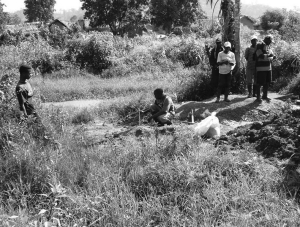Highlights from pre-feasibility drilling at Banro’s (BAA-T, BAA-X) Namoya project in the Democratic Republic of the Congo include 18.6 metres grading 20.15 grams gold per tonne and 7.3 metres grading 73.67 grams gold per tonne, the company says.
The assay results from 33 core holes will contribute to efforts underway to upgrade the project’s inferred resources into measured and indicated categories as part of a pre-feasibility study due in June.
Namoya has an indicated resource of 8.9 million tonnes grading 3.27 grams gold per tonne for 938,800 oz. and another 7 million inferred tonnes grading 2.73 grams gold for 621,500 oz.
The 174-sq.-km Namoya project is 225 km southwest of the town of Bukavu in the country’s eastern Maniema province. The property is made up of four separate deposits: Mwendamboko and Muviringu to the northwest, Kakula in the centre and Namoya Summit to the southeast.
Other notable intersects from the recent drill program include: 21.3 metres grading 6.56 grams gold per tonne; 23.9 metres grading 5.07 grams gold per tonne; 19.7 metres grading 4.94 grams gold per tonne; 33.6 metres grading 2.26 grams gold per tonne and 18.8 metres grading 3.28 grams gold per tonne.
Banro acquired 100% of the project in 1996. The gold exploration company then spent the next two years consolidating and interpreting a vast library of exploration data and confirmed Namoya’s five historical deposits: Mwendamboko, Muviringu, Kakula, Namoya Summit and Filon B, all of which host significant gold mineralization.
Banro planned to start an exploration program in December 1998, but political unrest got in the way. Instead, its field team conducted a detailed investigation of Namoya’s historical data.
Following a peace accord in 2002 and the inauguration of a transitional government headed by President Joseph Kabila in 2003, Banro kicked off exploration at Namoya in November 2004.
The first phase of drilling began in August 2005 and consisted of 70 diamond drill holes totaling 9,400 metres drilled parallel and close to, or just below, existing adit data. In the second phase of drilling, 36 diamond drill holes totalling 7,400 metres were completed in May 2007.
A scoping study estimated average annual production at 165,000 oz. gold per year over an 8-year mine life. Operating cash costs were estimated at US$217 per oz. for the first five years of production (average US$238 per oz. over eight years).
Post-tax net present value was anticipated at US$204 million based on a 5% discount rate and a gold price of US$600 per oz., with an internal rate of return of 37%, and a 2.3-year payback period.
Alluvial deposits of gold were first discovered at Namoya in 1930 and mined between 1931 and 1947. Primary gold was also discovered at that time and underground mining on the Filon B deposit began in 1947.
Further discoveries of primary gold mineralization were then made at Mwendamboko, Kakula, Namoya Summit and Muviringu. The majority of the mining there was based on small-scale underground development along mineralized quartz veins or stock-work zones.
During the 1950s a small open pit was established on the summit of Mwendamboko. Mining ceased in 1961, but substantial resources in the various deposits remained — as well as several untested targets.
Apart from Namoya, Banro is developing three other major, wholly owned gold projects along the 210- km Twangiza-Namoya gold belt in the South Kivu and Maniema provinces of the DRC.
Banro is trading on the Toronto Stock Exchange at about $7.80 per share and has a 52-week trading window of $7.75-$13. The Torontobased company has 41.1 million shares outstanding.


Be the first to comment on "Banro reports strong intersects at Namoya gold project (May 12, 2008)"